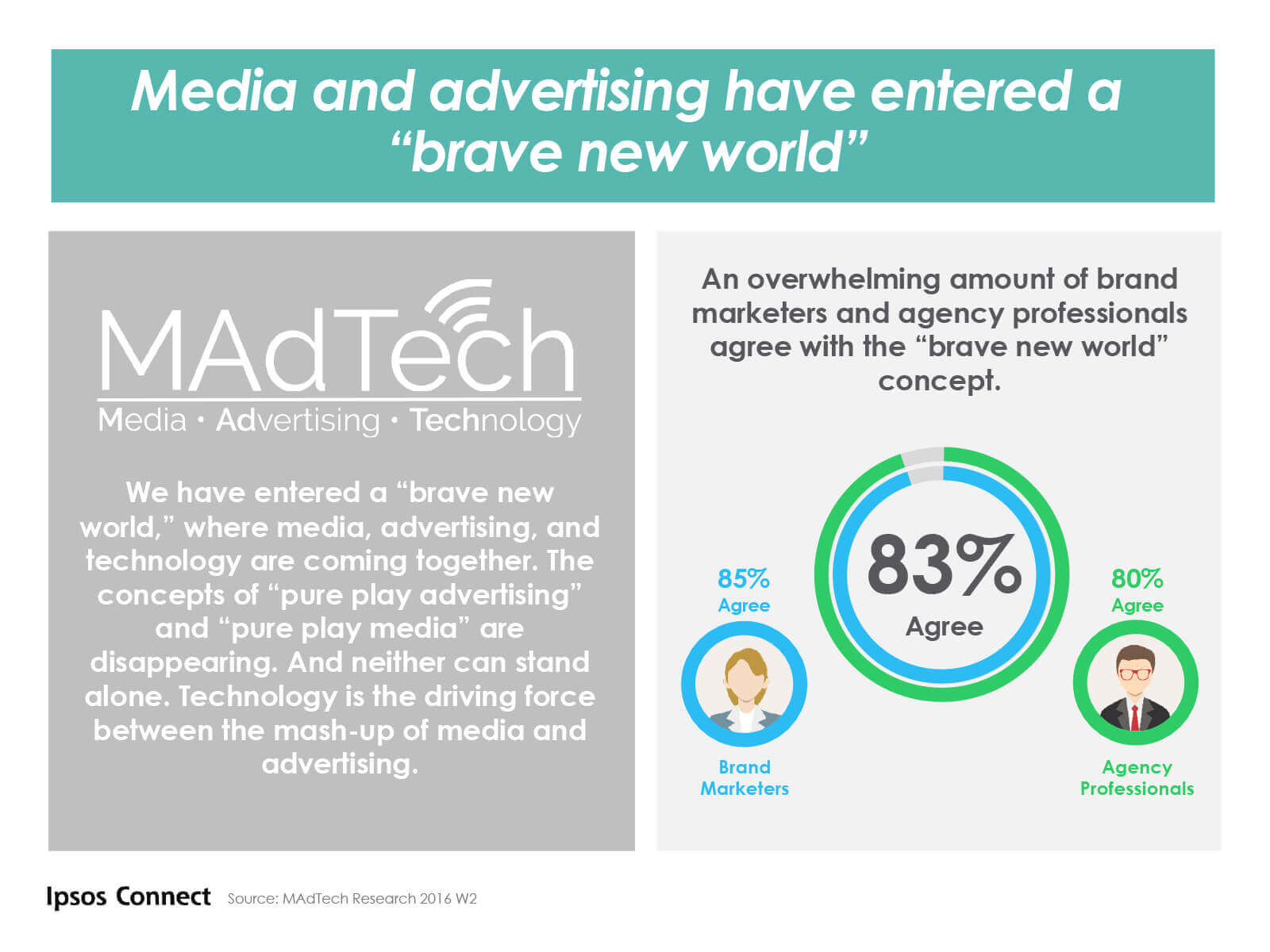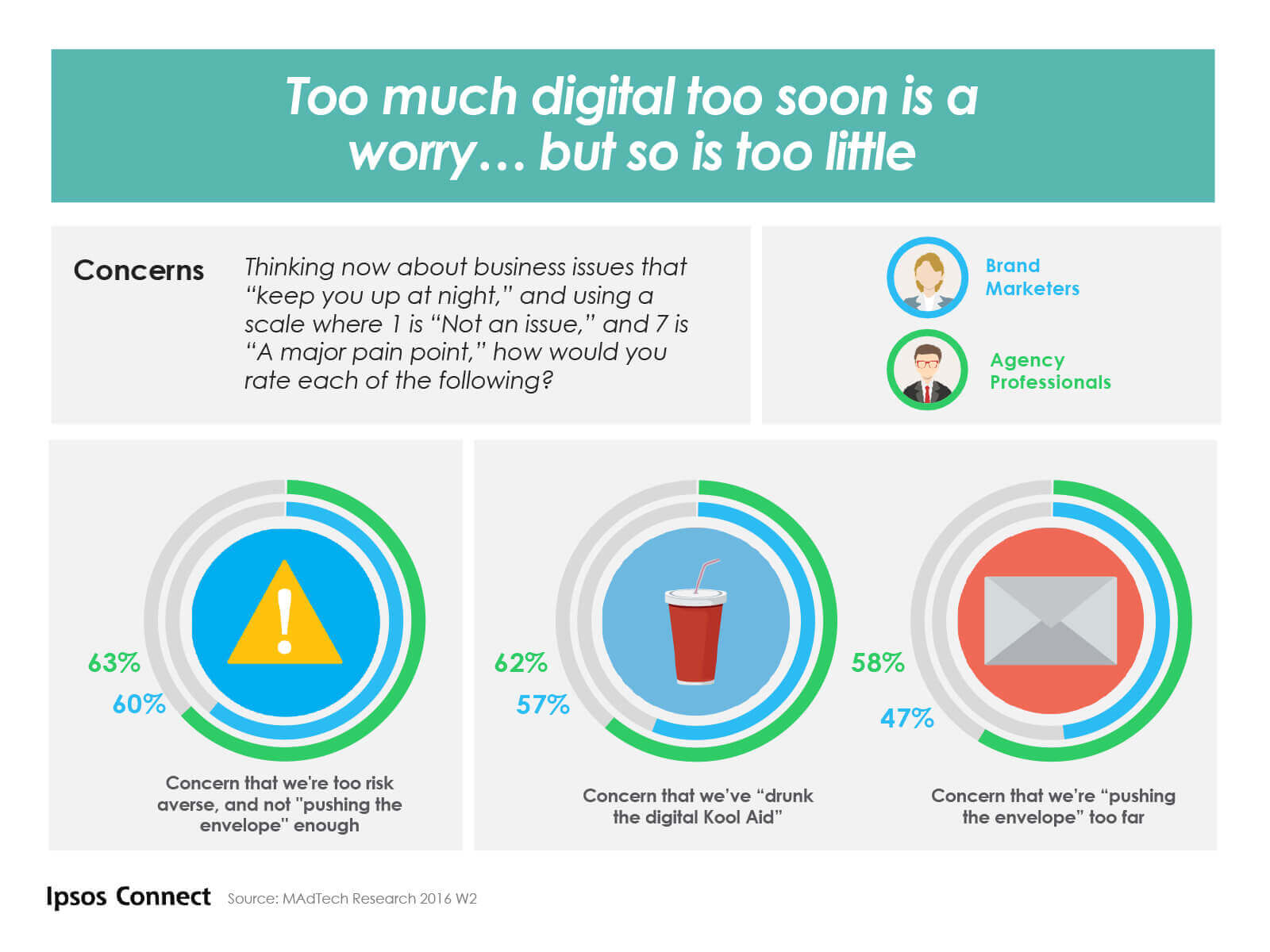MAdTech: The marketers’ view
As media, advertising and technology become increasingly interwined, contributor Peter Minnium takes a look at how marketers and agencies are responding to this mad, mad, MAdTech world.
The modern landscape of media, advertising and technology — “MAdTech” — has become increasingly muddled.
The means by which marketers need to advertise and media and platform companies need to relate to customers and advertisers are irrevocably changed and continuing to transform.
So exactly how does a company scale in the MAdTech marketplace? Ipsos Connect (my employer) has invested in understanding the foremost ideas, brands, content, advertising and technology emerging in this hyper-connected environment.
Over the past 12 months, we’ve completed two waves of research, tapping into the minds of over 600 professionals to capture the voice of marketers and their agencies. The latest findings on how these entities operate in the MAdTech world will help others better navigate the near-term future.
Is MAdTech real? It certainly is.
Eighty-three percent of respondents agree that we have entered a “brave new world” where media, advertising and technology are coming together. The standalone businesses of pure-play advertising and pure-play media are disappearing, and neither can stand alone.
Technology is the driving force behind the mashup.
Not surprisingly, the majority of respondents felt that companies must evolve in this new world.
Two-thirds of executives, however, want the change to be faster — in fact, to be revolutionary — if their companies are to survive and thrive.
MAdTech changes everything
The implications for advertising and media are far-reaching, and for the most part, agency influencers and marketers have positive sentiments about the increasingly influential role of technology in their businesses.
The majority of brand marketers and agency executives agree that technology makes reaching audiences easier and advertising more effective; improves the customer experience; and allows marketers to be present throughout all phases of the customer’s journey.
Not all change is deemed positive, however.
Time does not seem to be ameliorating this. Rather, since our first wave of the research in early 2016, agreement is going up that technology has shortened customers’ attention spans, made it harder to garner attention and downgraded the power of marketing. Only time will tell if this is a trend or a blip.
Still, agreement with the positive changes wrought by technology is significantly higher than agreement levels with the downsides.
Among the most tangible items that MAdTech has changed is how media spend is allocated.
Respondents in the survey indicated that in 2016 the split between digital and analog media spend was two-thirds and one-third.
Moreover, they told us that the shift of dollars to digital media will grow to 73 percent of budgets in 2021.
This is by no means a granular revenue count, but it seems clear that as people and content and distribution move further into the digital world, so does media spend.
MAdTech changes nothing
Some would say that despite all the transformations in the MAdTech world, nothing really has changed. In many respects, this rings true. Media and advertising are ultimately about people and how those people choose brands, platforms and programs.
When asked about the “things that keep them up at night,” the lack of consensus about how far to go — how much change in media and advertising is appropriate in the MAdTech world — comes out.
Too much change, too soon is a worry — but so is too little change.
While the concern that we’re too risk-averse is higher than the concern that we are pushing the envelope too far, roughly two-thirds of respondents believe that “we’ve drunk the digital Kool-Aid.”
In short, there is a degree of unease — a lack of consensus about how much to change and how far to go and how fast.
MAdTech implications
MAdTech means the reinvention of storytelling.
Brands have the opportunity and the task of building story systems for their messages, tying myriad pieces together to create a whole. Today’s stories, the parts people play in them, and the ways the messages can change as they traverse the ecosystem mean fundamental changes in storytelling and the role of the storyteller.
Marketers and agencies fully understand this challenge. Over 80 percent agree that “brands should embrace the notion that consumers create their own narratives that advertisers can join,” “It is important for brand advertising to be associated with new narrative forms that do not rely on traditional commercial messaging,” and ”Brands must have content assets to build their own narratives.”
MAdTech means an uncontrolled communications supply chain — the sequence of processes involving the creation, production and distribution of communications to the customer.
More than 70 percent of brand marketers agree that the marketing ecosystem is characterized by an unruly and uncontrolled supply chain, one where brands are no longer in control.
Fully 87 percent agree that interactivity allows for the co-creation of the advertising by and with consumers. Digital advertising is allowing for a level of interaction among marketers, consumers and the media so that the three are becoming partners in the advertising experience — often as co-creators.
MAdtech means there is no longer a dominant video screen.
While no one questions the power of sight, sound and motion — especially when it communicates a good yarn — the majority of agency executives and brand marketers surveyed agree that the notion of a dominant screen is not the definitive parameter of the video experience. Instead, the focus is on reaching the right people at the right moment regardless of screen.
MAdTech means a changing advertising economy.
At nearly identical high levels, marketers and agency execs agree that MAdTech is altering the impression-based economy, and it’s moving to one that is attention-based — one where brands will be required to gain attention and not rely on exposure alone.
The majority of those who agree with that statement (78 percent) report that they are likely to pay for brand advertising on an attention-based rate within the next year. The implications of this are enormous for the business of digital advertising; consider the challenge of defining and operationalizing attention in a simple way that can be used to determine ad rates.
MAdTech pain points
MAdTech brings new pain points and new twists on old problems.
Data can be particularly difficult for both marketers and agency professionals: 69 percent found the amount of data overwhelming, and finding actionable insights in data (72 percent) was also a significant pain point.
The measurement of impact and effectiveness of programmatic ad campaigns, despite their relative newness, is also high up on the list (71 percent).
Navigating and understanding the increasingly complex world of media and advertising (69 percent), achieving advertising breakthrough (68 percent), and digital ad blocking (64 percent) are all top pain points.
When we look at where help is needed, clearly the MAdTech world presents an array of challenges that must be overcome to succeed, and there is a willingness by professionals to acknowledge that they need help doing so.
Maximizing breakthrough and engagement are among both agency and marketer Top 5 items that they need help with to succeed. And so are platform-tailored messaging, as well as platform-agnostic approach, an apparent opposition that merits deeper understanding.
Tracking brand effectiveness and ROI measurement are also areas that can help marketers and agencies succeed.
It’s a mad, mad, MAdTech world
Media, advertising and technology have become inextricably linked, with profound implications across the ecosystem. Industry leaders view the changes as largely positive as they facilitate connecting with audiences of consumers. Clearly, it makes complex what once was simple, and a growing minority thinks that technology downgrades the power of marketing.
For brand marketers, agency professionals and storytellers, there is a need for deeper creativity and smarter approaches to marketing than ever before.
Above all, know thy consumer and to thy brand be true.
Opinions expressed in this article are those of the guest author and not necessarily MarTech. Staff authors are listed here.
Related stories













